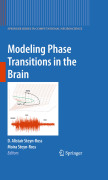
The induction of unconsciousness using anesthetic agents demonstrates that the cerebral cortex can operate in two very different behavioral modes: alert and responsive vs. unaware and quiescent. But the states of wakefulness and sleep are not single-neuron properties---they emerge as bulk properties of cooperating populations of neurons, with the switchover between states being similar to the physical change of phase observed when water freezes or ice melts. Somebrain-state transitions, such as sleep cycling, anesthetic induction, epileptic seizure, are obvious and detected readily with a few EEG electrodes; others, such as the emergence of gamma rhythms during cognition, or the ultra-slow BOLD rhythms of relaxed free-association, are much more subtle. The unifying theme of this book is the notion that all of these bulk changes in brain behavior can be treated as phase transitions between distinct brain states. Modeling Phase Transitions in the Brain contains chapter contributions from leading researchers who apply state-space methods, network models, and biophysically-motivated continuum approaches to investigate a range of neuroscientifically relevant problems that include analysis of nonstationary EEG time-series; network topologies that limit epileptic spreading; saddle--node bifurcations for anesthesia, sleep-cycling, and the wake--sleep switch; prediction of dynamical and noise-induced spatiotemporal instabilities underlying BOLD, alpha-, and gamma-band Hopf oscillations, gap-junction-moderated Turing structures, and Hopf-Turing interactions leading to cortical waves." Presents recent developments in EEG data analysis Places cortical modelling in historical context Provides an overview of the range of modern mass-action continuum approaches used to model cortical function INDICE: Foreword. Preface. Introduction and overview. Phase transitions insingle neurons and neural populations: critical slowing, anesthesia, and sleep cycles. Generalized state-space models for modeling nonstationary EEG time-series. Spatiotemporal instabilities in neural fields and the effects of additive noise. Spontaneous brain dynamics emerges at the edge of instability. Limited spreading: how hierarchical networks prevent the transition to the epileptic state. Bifurcations and state changes in the human alpha rhythm: theory and experiment. Modeling phase transitions in mesoscopic brain dynamics. Phase transitions in physiologically-based multiscale mean-field brain models. A continuum model for the dynamics of the phase transition from slow-wave sleep to REMsleep. What can a mean-field model tell us about the dynamics of the cortex? Phase transitions, cortical gamma, and the selection and read-out of information stored in synapses. Cortical patterns and gamma genesis are modulated by reversal potentials and gap-junction diffusion.
- ISBN: 978-1-4419-0795-0
- Editorial: Springer
- Encuadernacion: Cartoné
- Páginas: 350
- Fecha Publicación: 01/02/2010
- Nº Volúmenes: 1
- Idioma: Inglés
